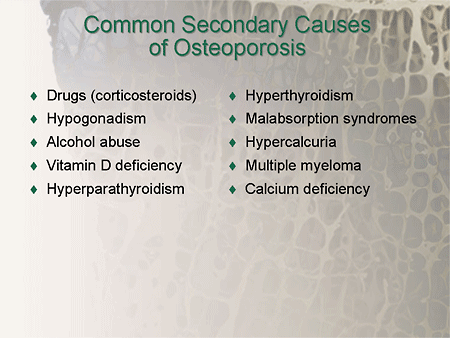Team members
Names / Roles:
- [Dina] (Leader)
- [Richelle] (Editor)
- [Shi Jie] (Researcher)
- [Zhi Wei] (Researcher)
Meaning / Definition

Thinning of the bones, with reduction in bone mass, due to depletion of calcium and bone protein. Osteoporosis predisposes a person to fractures, which are often slow to heal and heal poorly. It is most common in older adults, particularly postmenopausal women, and in patients who take steroids or steroidal drugs.Unchecked osteoporosis can lead to changes in posture, physical abnormality, and decreased mobility.
Causes and Effects

Osteoporosis is caused due to loss of calcium and other mineral components like when there is low estrogen in women, low testosterone in men,lack of vitamin D, a sedentary lifestyle and most importantly smoking. When there is low estrogen in women means that bone loss accelerates after menopause, therefore when older women have a quick drop in estrogen , the risk of osteoporosis and fracture increases.The reason of that is because they loses more bones before they are replaced. Men need testosterone and estrogen for bone health. They need testosterone to convert into bone-preserving estrogen so if they got lack of testosterone increases the risk of osteoporosis. When there is a lack of vitamin D, it will make the bone weak and therefore increasing the bone loss. A sedentary lifestyle is like the early astronauts.Some astronauts suffer from osteoporosis because when they go up to space they will be weightless so they face rapid bone loss.Smokers suffers from low bone density and a higher risk of fracture than non-smokers.
Signs and Symptoms

Osteoporosis means "porous bones." If you have osteoporosis, your bones don't look any different, but they lose substance as well as calcium and other minerals. As a result, your bones have less strength and are more likely to fracture, particularly if you fall.The most common osteoporosis fractures resulting from falls are in your wrist or hip. You are much more likely to have compression fractures in your vertebrae, the bones in your spine. A compression fracture is the result of the weakened bone cracking from the normal pressure of being upright. This often results in the curvature of the spine at the shoulders in older people sometimes called a "widow's hump."
Prevention and Treatment

Three factors essential for keeping your bones healthy throughout your life are:
- Adequate amounts of calcium
- Adequate amounts of vitamin D
- Regular exercise
Men and women between the ages of 18 and 50 need 1,000 milligrams of calcium a day. This daily amount increases to 1,200 milligrams when women turn 50 and men turn 70.
Vitamin D is necessary for your body to absorb calcium. Many people get adequate amounts of vitamin D from sunlight, but this may not be a good source if you live in high latitudes, if you're housebound, or if you regularly use sunscreen or you avoid the sun entirely because of the risk of skin cancer.
Exercise can help you build strong bones and slow bone loss. Exercise will benefit your bones no matter when you start, but you'll gain the most benefits if you start exercising regularly when you're young and continue to exercise throughout your life.
Although there is no cure for osteoporosis, there are steps you can take to prevent, slow or stop its progress. In some cases, you may even be able to improve bone density and reverse the disorder to some degree. Getting enough calcium and vitamin D as well as are essential to bone health. There are also medications available to reduce the risk of broken bones. These medicines either (1) slow or stop bone loss or (2) rebuild bone.
Link to Other Illnesses or Diseases
Rheumatoid Arthritis (RA): RA is a form of arthritis that is associated with an increased risk for osteoporosis. Steroid medicines, which are used to treat RA, can also increase the risk of osteoporosis.
Lupus: People with lupus may need to take medicines, including steroids, to control their symptoms. These medicines can lead to bone loss and osteoporosis.
Ceilac Disease: People with celiac disease have trouble digesting foods with gluten. Gluten is found in grains such as wheat, rye and barley. People with celiac disease also have problems absorbing nutrients, including calcium and vitamin D. Celiac disease doesn't always cause noticeable symptoms. Ask your doctor if you should have a test for celiac disease.
Inflammatory Bowel Disease (IBD): Different forms of IBD, such as Crohn's colitis, can cause bone loss. Steroid medicines are often used to treat these conditions, which can also contribute to bone loss. People with IBD may also have trouble absorbing the calcium and vitamin D needed for healthy bones.
Weight Loss Surgery; Weight loss procedures such as gastric bypass surgery can help people lose a large amount of weight in a short period of time. This weight loss may lead to bone loss. These procedures can also interfere with the body’s ability to properly absorb the vitamins and minerals needed for bone health.
Reference
http://www.medterms.com/script/main/art.asp?articlekey=4686
http://www.webmd.com/
http://www.ucsfhealth.org/conditions/osteoporosis/signs_and_symptoms
http://www.mayoclinic.org/diseases-conditions/osteoporosis/basics/prevention/con-20019924
http://nof.org/live/treating
http://nof.org/articles/5
Comments (1)
tan_wei_zhi@moe.edu.sg said
at 9:10 am on Jul 1, 2014
Are there problems? There is no information put up yet.
You don't have permission to comment on this page.